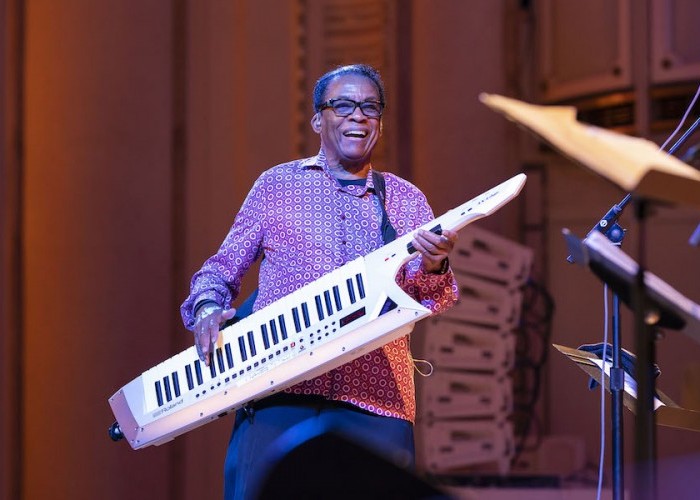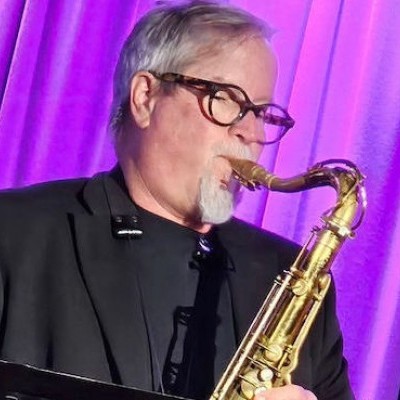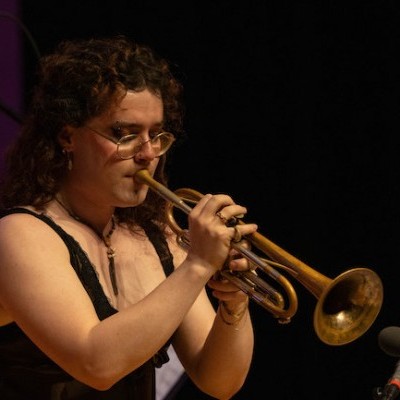Oct 28, 2025 10:47 AM
In Memoriam: Jack DeJohnette, 1942–2025
Jack DeJohnette, a bold and resourceful drummer and NEA Jazz Master who forged a unique vocabulary on the kit over his…

Herbie Hancock, and his keytar, drew standing ovations during his Chicago homecoming concert.
(Photo: Clay Baker)As Herbie Hancock demonstrated in his recent return to performance, he is a musician of multitudes. The youthful 81-year-old NEA Jazz Master, UCLA professor, chair of the Herbie Hancock Institute of Jazz and UNESCO Good Will Ambassador for Intercultural Dialogue packed both his live-in-person quintet concert at Chicago’s Symphony Center on Sept. 2 (and the Detroit Jazz Festival show the next night, streamed rather than held in public as had been planned) with compositions, improvisations, keyboard investigations, artistic concepts and the leadership style he’s developed in a career spanning at least 60 years. His U.S. tour continues through the month.
In Chicago, an eerie, free-form episode that suggested Hancock’s early 1970s Mwandishi ensemble was the opener; in Detroit, Hancock made time to play “Windows” in dedication to his late “life-long best friend” and colleague Chick Corea. Otherwise, the set lists were similar, with in-the-moment variations of interpretation.
Sitting between two electric instruments and a Fazioli grand piano with his keytar nearby, Hancock switched among his voices and styles quickly, as if trying to fit them all in. He evoked the enduring quality of his 1960s Blue Note beginnings with the evergreen “Cantaloupe Island” and his funk-fusion pre-eminence with his hit “Chameleon,” arranged to sound like now, not then. After setting up themes on electric gear with his front line in closely focused voicings, and syncing with the rhythm team’s pocket, he frequently swiveled to play rich and driving chords on the grand. The mix of electric and acoustic instruments is often problematic, and in Symphony Center some piano nuances were lost in the overall sound, but viewed by a closeup camera online, Hancock’s harmonic sophisticated and finger fleetness stood out clearly.
Ever sensitive to musicians on the rise, Hancock arranged “Absolute Proof” as a set-piece featuring the soloistic talents of his guitarist-vocalist Lionel Loueke, flutist-vocalist Elena Pinderhughes, electric bassist James Genus and drummer Justin Tyson (who hit his kit hard, with tall baffles between him and his leader). Miles Davis spotlit Hancock, Wayne Shorter, Ron Carter and Tony Williams during their years in his employ with an air of diffidence; Herbie in contrast is vocal in his pride for his younger band members and generous in his accompaniment to them.
Loueke sang in an African language of his native Benin and scatted playfully in addition to showing off his clipped and/or beady processed guitar sounds. Pinderhughes’ flute rode the treble lines tightly, her flute contributions virtuosic, her intonation so focused as to bear no hint of breath behind it. One climax of the Chicago event was her trading of fours with Hancock standing next to her, stage front, wielding his keytar.
Hancock, born and raised in Chicago, where he was recognized as a prodigy, is clearly still enthusiastic about the instruments whose uses he pioneered. Besides his strap-held ax and various synths, he offered up one tune on vocoder. Aficionados of one facet or another of his career might carp they didn’t hear enough “Watermelon Man” or “Maiden Voyage,” “Future Shock,” anything from Speak Like A Child or Gershwin’s World or The Joni Letters. But this is a typical issue for artists trying to represent their many decades of original explorations in 90 or 120 minutes. Herbie Hancock’s audiences seem to be generally understanding about the problem, and unconcerned. In Chicago, he was greeted with a standing ovation and rewarded with the same at the concert’s end. DB

Jack DeJohnette boasted a musical resume that was as long as it was fearsome.
Oct 28, 2025 10:47 AM
Jack DeJohnette, a bold and resourceful drummer and NEA Jazz Master who forged a unique vocabulary on the kit over his…

“I’ve told students, ‘I don’t mind if you use AI for this or that project,’” says MIT’s Pascal Le Boeuf. “‘But you need to tell me.’”
Sep 18, 2025 11:14 AM
A standard joke when it comes to discussing artificial intelligence, or AI, is that it’s developing so rapidly that…

Chuck Manning Works for NASA … and plays jazz.
Sep 18, 2025 11:23 AM
Congratulations! After years of study, you’ve earned your degree in jazz performance. But let’s face it: Making a…

Always a sharp dresser, Farnsworth wears a pocket square given to him by trumpeter Art Farmer. “You need to look good if you want to hang around me,” Farmer told him.
Sep 23, 2025 11:12 AM
When he was 12 years old, the hard-swinging veteran drummer Joe Farnsworth had a fateful encounter with his idol Max…

“Make time and energy to meet people and make friends,” suggests Millie Ahearn, a student at DePaul University.
Sep 18, 2025 11:32 AM
For many students, the transition into a collegiate jazz program can feel overwhelming — new peers, unfamiliar…